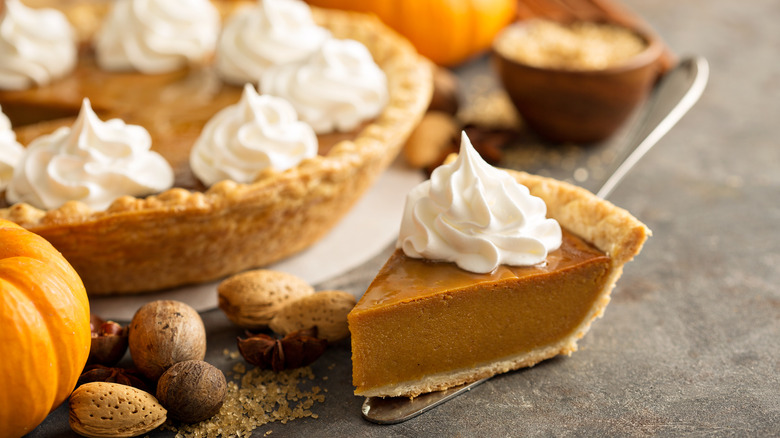The Temperature Of One Ingredient Is Essential To A Perfect Pie
Oh, pie. That wonderful combination of flaky crust and dreamy filling is the ultimate goal of every baker. And the perfect pie does exist. The filling must be delicious and flavorful, not too runny, but easy to cut through with the side of a fork. And the crust must be flaky and light, sturdy enough to hold together, but tender enough to cut with that fork. Most recipes will help you make a good pie, but how do you elevate it into the perfect realm?
Make the perfect pie crust.
The part of a pie that most bakers find challenging is the crust. There are so many recipes and tips that the whole process can seem bewildering. Pie crusts can be finicky and there are lots of rules to follow. You can make a crust of cookie crumbs, but some pie recipes just call out for a real crust made with flour, fat, and water. For best results, you need a light but firm hand and some great tricks.
We've all had pies with soggy crusts, with crusts that resist your fork, and with crusts that are mealy or just a solid mass. How do you make a great pie crust that will work no matter what the filling? As it turns out, the temperature of one of the crust's ingredients is the key to the perfect pie.
Keep it cold
To make the best pie crust, the butter must be very cold, according to Food Network. In fact, Bon Appétit says that you should use the butter right out of the fridge, and while you're at it, chill the bowl and the utensils you use too.
The temperature matters because of how the butter and flour act in the oven, according to Popular Science. When you add the butter to the flour, you are setting it up to create little air pockets, interrupting the flour's gluten structure. In the oven, the fat of the butter melts and releases water, which creates steam. The steam separates the gluten web in the flour, making those desirable flaky layers. But if the butter is too soft, it will just blend with the flour. So no layers, no steam, and no flaky pie crust.
To increase your odds of a flaky pie crust even more, you can chill the flour and butter in the freezer before you start combining the two, according to The Oregonian, and use ice water to bring the dough together. If you have warm hands, Popular Science suggests you consider using a pastry blender to work the fat into the flour instead of your fingers.
Make your own perfect pie crust
Now that you have all of the ingredients for the perfect pie crust, make a space in the fridge and freezer for the ingredients and get going. Try our favorite pie crust (this recipe even freezes the shortening!), or bring another kitchen utensil into the mix and use a cheese grater to get that butter to the perfect consistency. With that method, you do not have to work the butter into the flour, so it stays cold and you get perfect flaky layers in the crust. You can also make a whole wheat pie crust.
Now that you have mastered pie crust, how will you fill it? You could run through the iconic pies from every state in the nation, or try the irresistible crack pie. Make a sweet and sticky pecan pie, or try hummingbird pie. And to complete your repertoire, go savory with a recipe for classic bacon and cheddar quiche, or a wonderful tomato pie made with cheese, garlic, and green onions.


